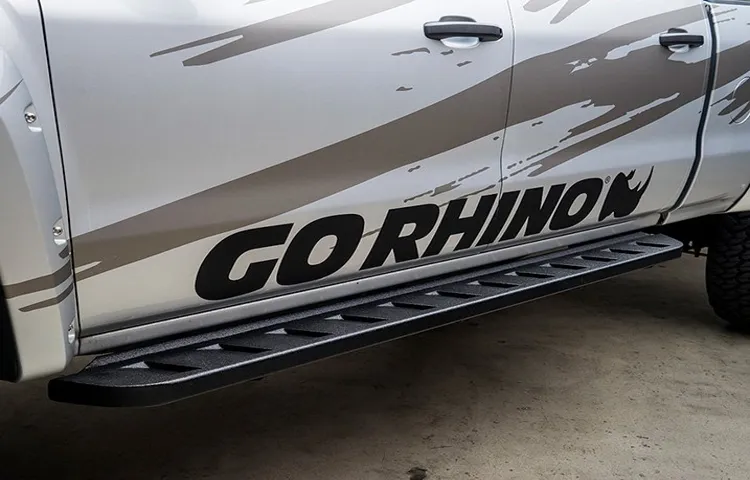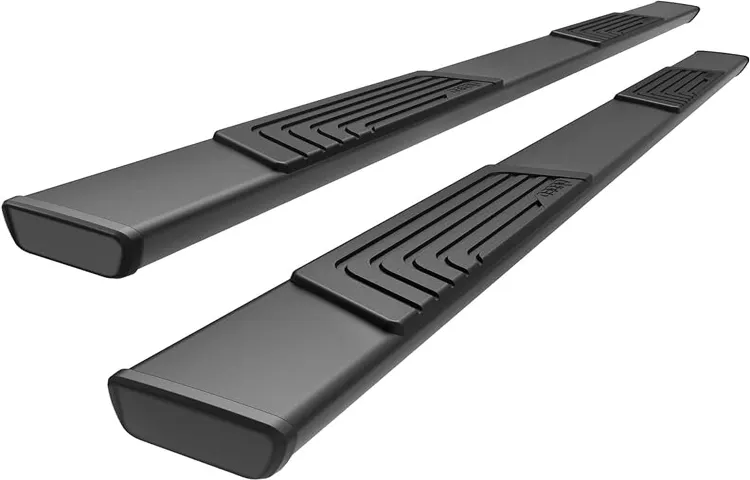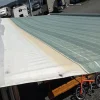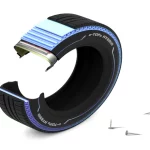If you’ve ever glanced at a pickup truck or an SUV and wondered about that long, flat strip just below the doors, you’re not alone. Those sleek, elongated surfaces known as running boards often leave people scratching their heads. But fear not! In this blog, we’re going to dive into the world of running boards and uncover their purpose and importance.
Think of running boards as the superhero sidekick of your vehicle. They may not fly or possess superhuman strength, but they provide a helping hand when it comes to getting in and out of your ride. Acting as a step or platform, running boards offer a convenient foothold, especially for those with shorter stature or mobility issues.
But running boards aren’t just practical; they add a touch of style and functionality to your vehicle as well. Think of them as the cute yet functional accessories that enhance the appearance and utility of your ride. They come in various materials, including aluminum, stainless steel, or even durable plastic, and can be customized to match your vehicle’s color or design.
Functionality aside, running boards also serve as a protective barrier. They shield the lower part of your vehicle’s body from road debris, mud, and other unwanted elements that can cause damage or corrosion. So not only do they look good, but they also provide a layer of defense for your vehicle’s exterior.
In a nutshell, running boards are the unsung heroes of the automotive world. They offer a practical and stylish solution for easier vehicle entry and exit, while also providing protection for your beloved ride. Whether you’re admiring an SUV or eyeing a pickup truck, now you’ll know that those sleek strips along the sides are more than just a fancy design feature; they’re running boards, keeping you stylishly safe on the road.
Table of Contents
Definition
Running boards are a popular addition to trucks, SUVs, and some larger vehicles. But what exactly is a running board? Well, imagine you’re trying to climb into a tall truck. It can be quite a struggle, especially if you’re not the tallest person around.
That’s where running boards come in handy. They are long flat platforms that are mounted along the sides of a vehicle, just below the doors. These boards provide a step for you to easily climb into the vehicle, giving you a boost in height and making the whole process much easier.
Running boards come in various materials, including aluminum, stainless steel, and plastic, and they can be customized to match the style and aesthetics of your vehicle. So next time you see a truck with a shiny set of running boards, you’ll know exactly what they’re for – making it easier to hop in and out of the vehicle.
Explanation of what a running board is and its purpose
A running board is a feature found on the sides of vehicles, typically located between the front and rear wheels. Its purpose is to provide an extra step for passengers to use when entering or exiting the vehicle, especially for taller vehicles like trucks and SUVs. Running boards are designed to be sturdy and durable, providing a stable surface for people to step on.
They can be made from various materials such as metal or plastic, and they may have a non-slip surface to ensure safety. The primary function of a running board is to make it easier and more convenient for passengers to access the vehicle, reducing the risk of slips or falls. Additionally, running boards can also serve as a decorative feature, adding style and flair to the vehicle’s exterior.
So, next time you step into a tall vehicle, take a moment to appreciate the useful and practical design of the running board.

Overview of different types of running boards
Running boards are an important accessory for any vehicle, providing convenience and style. But what exactly are running boards? Simply put, running boards are long, narrow steps that are attached to the side of a vehicle, typically between the front and rear wheels. They are used to make it easier for passengers to get in and out of the vehicle, especially for taller vehicles like trucks and SUVs.
Running boards also serve as a protective barrier, keeping the sides of the vehicle safe from road debris, mud, and other hazards. Overall, running boards are a functional and stylish addition to any vehicle, providing both practicality and an enhanced aesthetic appeal.
Benefits
A running board is a type of accessory that is installed on the side of a vehicle, typically near the doors. It serves as a step or platform that provides an easier way to get in and out of the vehicle. Although it is often associated with older models of trucks and SUVs, running boards are still popular today and can be found on various types of vehicles.
While some may consider running boards to be purely decorative, they actually offer a number of benefits. One of the main advantages of having running boards is improved accessibility. They provide a sturdy surface to step on, making it easier for passengers, especially those with mobility issues or children, to enter and exit the vehicle.
Additionally, running boards can also help protect the lower body of the vehicle from scratches, dents, and other damages. They serve as a buffer between the body of the vehicle and any debris that may come into contact with it. Another benefit of running boards is that they can enhance the appearance of the vehicle.
They come in various styles and materials, allowing vehicle owners to customize their look and add a touch of personalization. Overall, running boards are a practical and stylish accessory for any vehicle, providing both functionality and aesthetic appeal.
Improved vehicle accessibility
Improved vehicle accessibility offers a multitude of benefits for individuals and society as a whole. One of the key advantages is the increased independence and freedom it grants to people with disabilities or mobility issues. With improved accessibility features, such as ramps, lifts, and modified controls, individuals who previously relied on others for transportation can now drive themselves, enabling them to go about their daily lives more autonomously.
This increased independence not only enhances their quality of life but also provides opportunities for better education, employment, and social interactions. Moreover, improved vehicle accessibility promotes inclusivity and equality by breaking down barriers and allowing everyone to participate in various aspects of life. This not only benefits the individuals directly but also fosters a more inclusive and diverse society.
Additionally, enhanced accessibility in vehicles can lead to a more efficient and convenient transportation system. By ensuring that vehicles are accessible to all, transportation options become more readily available to a wider range of people, reducing the reliance on overcrowded public transportation and enabling individuals to travel comfortably and conveniently. Ultimately, improved vehicle accessibility is a crucial step towards creating a society where everyone can participate fully and equally.
Added protection for the side of the vehicle
side vehicle protection, benefits of added protection for the side of the vehicle
Enhanced appearance
One of the primary benefits of enhancing your appearance is the boost in self-confidence it provides. When you feel good about how you look, it shows in your demeanor and interactions with others. The way you present yourself can have a significant impact on how people perceive you, both personally and professionally.
By taking the time to enhance your appearance through various means such as grooming, dressing well, and taking care of your physical health, you can exude a sense of confidence and self-assuredness that is contagious. When you feel good about yourself, it radiates to those around you, making you more attractive and approachable. Moreover, enhancing your appearance can also lead to a positive shift in how you perceive yourself, improving your self-esteem and overall well-being.
So why not invest a little time and effort in enhancing your appearance? The benefits are not just external; they can have a profound impact on your inner self as well.
Installation Process
If you’ve ever seen a car or truck with a long flat step along the side, then you’ve seen a running board. But, have you ever wondered what it’s actually for? Running boards are typically installed on vehicles that have a high ground clearance, like pickup trucks and SUVs, to make it easier for passengers to get in and out of the vehicle. They act as a step or platform, providing a stable surface for people to step on when entering or exiting the vehicle.
Not only do running boards make it easier to access the vehicle, but they can also add a stylish and rugged look to your vehicle. The installation process for running boards will vary depending on the make and model of your vehicle. Typically, it involves attaching the running boards to the frame of the vehicle using hardware like bolts or brackets.
It’s important to follow the manufacturer’s instructions for installation to ensure a secure and proper fit. Once installed, running boards can provide a practical and aesthetic enhancement to your vehicle.
Step-by-step guide on how to install a running board
Step-by-step guide on how to install a running board So, you’ve decided to install a running board on your vehicle. Great choice! Running boards not only add style to your ride but also provide a practical advantage, making it easier to step in and out of your vehicle. But how do you go about installing one? Don’t worry, we’ve got you covered.
In this step-by-step guide, we’ll walk you through the installation process, ensuring you’ll have your new running board up and running in no time. First things first, gather all the necessary tools and materials. You’ll need a wrench, a socket set, a drill, a drill bit set, a measuring tape, an adjustable wrench, and the running board kit itself.
Make sure you have all the components and hardware that come with the kit. Once you have everything you need, start by positioning the running board under your vehicle. Make sure it lines up with the mounting points on the side of your vehicle.
Use the measuring tape to ensure it’s centered and at the desired height. Once you’re satisfied with the placement, mark the drilling points on the vehicle’s body. Next, you’ll need to drill holes in the marked spots.
Use a drill bit that matches the size of the bolts included in the kit. Make sure to wear safety goggles and work slowly and carefully, avoiding any damage to your vehicle’s body. Once the holes are drilled, clean any metal shavings and debris.
Now it’s time to attach the brackets to the running board. Use the provided hardware and tighten the bolts securely. Double-check that the brackets are properly aligned and centered before moving forward.
Tools and materials required
To install a ceiling fan, there are a few tools and materials you will need to have on hand. Firstly, you will need a ladder to reach the ceiling, as well as a stud finder to locate a secure place to mount the fan. Additionally, you will need a screwdriver, wire connectors, electrical tape, wire cutters, and a voltage tester to ensure safety during the installation process.
It is important to have all of these tools readily available before you begin, as it will make the process much smoother and more efficient. Once you have gathered all of your tools and materials, you can begin the installation process. Make sure to read the instructions that came with your ceiling fan carefully, as each model may have specific installation requirements.
You will typically start by turning off the power to the room at the circuit breaker, and then attaching the mounting bracket to the ceiling. Next, you will connect the wiring from the fan to the existing electrical wiring in the ceiling, being sure to secure all connections with wire connectors and electrical tape. Finally, you will attach the blades to the fan and install any additional components, such as a light kit or remote control.
Once everything is securely in place, you can turn the power back on and enjoy the cool breeze from your newly installed ceiling fan.
Maintenance and Care
Running boards are an essential part of a vehicle that often goes unnoticed. So, what exactly is a running board? Well, it’s a small platform-like structure that is attached to the side of a vehicle, usually near the bottom. Its primary function is to provide an extra step for passengers to get in and out of the vehicle easily.
They are especially beneficial for tall vehicles such as trucks and SUVs, where the height can be challenging for some people to climb into. Running boards come in various materials, including aluminum, steel, and plastic, and can be customized to match the vehicle’s aesthetic. Not only do they make it easier to enter and exit the vehicle, but they also offer protection to the side panels from rocks, debris, and other road hazards.
So, the next time you see a vehicle with running boards, you’ll know exactly what they are and why they are essential.
Tips on how to clean and maintain running boards
running boards, clean, maintain Running boards are a popular accessory for trucks and SUVs, providing a convenient step to help you get in and out of your vehicle. However, with frequent use, they can quickly accumulate dirt, mud, and other debris. Regular cleaning and maintenance is important to keep your running boards looking their best and functioning properly.
Start by giving them a thorough wash with soap and water to remove any loose dirt. Use a soft brush or sponge to scrub away any stubborn grime. After cleaning, be sure to dry them completely to prevent water spots.
Applying a protective automotive wax can help to keep your running boards looking shiny and new. Additionally, it’s important to regularly inspect your running boards for any signs of damage or deterioration. Pay close attention to the mounting brackets and hardware, as these can loosen over time.
Tighten any loose screws or bolts, and replace any damaged or worn-out parts as needed. By following these simple tips, you can keep your running boards in great shape for years to come.
Recommended frequency for maintenance
“Maintenance and Care” When it comes to keeping your equipment in tip-top shape, regular maintenance is key. But how often should you schedule maintenance? Well, it depends on a few factors. The type of equipment you have, how often you use it, and the environment it operates in can all affect the recommended frequency for maintenance.
Generally, most manufacturers will provide guidelines on how often their equipment should be serviced. This can range from monthly to annually, depending on the equipment. It’s also important to listen to your equipment.
Does it sound different? Are there any strange vibrations or smells? These can be signs that maintenance may be needed sooner than the recommended interval. Remember, preventative maintenance is always better than waiting for a breakdown. So, be sure to stay on top of your equipment’s regular check-ups to avoid any unexpected surprises down the road.
Alternatives
What’s a running board? If you’ve ever spotted a vintage car or a rugged truck, chances are you’ve seen running boards. So, what exactly are these things? Well, a running board is a narrow platform that is mounted on the side of a vehicle, typically between the wheel wells. It runs parallel to the ground and provides a step for passengers to easily enter and exit the vehicle.
In the early days of automobiles, running boards were a common feature, but as car designs evolved, they became less prevalent. However, running boards can still be found on some vehicles today, especially those with a more rugged or retro aesthetic. If you want to add a touch of classic style to your car or truck, installing running boards might be the perfect choice.
They not only provide practical assistance but also give your vehicle a distinct look. Plus, they can be a fun conversation starter at car shows or among auto enthusiasts. So, whether you want to relive the glory days of motoring or simply make getting in and out of your vehicle easier, running boards are a great option.
Other options for adding accessibility and protection to the vehicle
If you’re looking for alternatives to enhance accessibility and protection in your vehicle, there are a few options you can consider. One alternative is installing a power lift or ramp, which can make it easier for individuals with mobility challenges to get in and out of the vehicle. These lifts and ramps are designed to be durable and reliable, and they can be customized to fit your specific needs.
Another option is adding additional safety features, such as blind spot detection systems or backup cameras. These technologies can help increase your awareness of your surroundings and reduce the risk of accidents. Additionally, you may want to look into protective coatings for your vehicle, such as ceramic coatings or paint protection films.
These coatings can provide an extra layer of defense against scratches, chips, and other damage. Overall, there are several alternatives available to improve the accessibility and protection of your vehicle, so you can find the solution that best fits your needs.
Comparison of running boards with other alternatives
running boards, alternatives
Conclusion
So, what’s a running board? Well, think of it as the sartorial equivalent of a catwalk for your car. It’s that sleek strip of metal or plastic that runs alongside the bottom of your vehicle, giving it a touch of elegance and a dash of practicality. Just like a model gracefully strutting down the runway, the running board adds an extra dimension of style and grace to any automobile.
But it’s not just about appearances, my friends. Oh no! The running board serves a utilitarian purpose as well. It’s there to assist you in gracefully entering and exiting your noble steed, offering a sturdy foothold and a helping hand when needed.
It’s like having your own personal red carpet, ensuring that every journey begins and ends with a touch of sophistication and ease. So, next time someone asks you, “what’s a running board?” you can confidently explain that it’s a fashion-forward accessory for any automobile, simultaneously providing both form and function. It’s the accessory that elevates your ride from ordinary to extraordinary, ensuring that you arrive at your destination in style, with a touch of panache that sets you apart from the rest.
Now, go forth my friends, and embrace the running board. Let it be your fashion statement, your practical companion, and your not-so-secret weapon for turning heads and commanding attention on the open road. Happy driving!”
Recap of the importance and benefits of running boards
running boards, importance, benefits, alternatives
Final thoughts and recommendations
In conclusion, there are several alternatives to consider when it comes to investing in the stock market. One option is to invest in mutual funds, which are managed by professionals and offer a diversified portfolio of stocks. Another alternative is to invest in exchange-traded funds (ETFs), which are similar to mutual funds but can be traded like individual stocks.
Both mutual funds and ETFs offer the benefit of diversification and professional management, making them suitable for investors who prefer a hands-off approach. For those who want more control over their investments, individual stocks or bonds may be a better option. Individual stocks allow investors to choose specific companies to invest in, while bonds provide a fixed income stream.
Ultimately, the best alternative for you will depend on your financial goals, risk tolerance, and investment preferences. It’s important to carefully evaluate each option and consult with a financial advisor before making any investment decisions.
FAQs
What is a running board?
A running board is a board or step that is mounted along the side of a vehicle, typically located between the front and rear wheels. It serves as a convenient step for passengers to enter or exit the vehicle.
Why are running boards used?
Running boards are used to provide easier access to vehicles, especially those with high ground clearance or larger sizes. They assist passengers in getting in and out of the vehicle comfortably.
Are running boards only found on specific types of vehicles?
No, running boards can be found on various types of vehicles, including trucks, SUVs, and some passenger cars. They are more commonly seen on larger vehicles.
What materials are running boards typically made of?
Running boards can be made from various materials such as steel, aluminum, fiberglass, or even high-strength plastics. The choice of material depends on factors like durability, weight, and design preferences.
Can running boards be customized?
Yes, running boards can be customized to match the vehicle’s design or owner’s preferences. They can be painted or coated in different colors, textures, or finishes to enhance the overall aesthetic appeal.
Do running boards serve any other purpose besides providing a step?
Besides acting as a step, running boards can also help protect the sides of the vehicle from road debris, stones, and scratches, especially in off-road conditions. They can also add a stylish and sporty look to the vehicle.
Can running boards be easily installed or removed?
Yes, most running boards are designed to be easily installed using simple tools, often without the need for professional assistance. However, the specific installation process may vary depending on the vehicle make and model.



